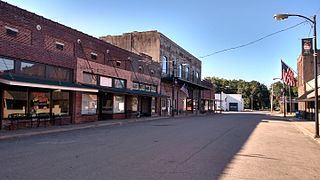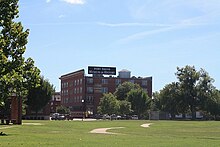
Fort Smith is the second-largest city in Arkansas and one of the two county seats of Sebastian County. As of the 2010 Census, the population was 86,209. With an estimated population of 87,891 in 2019, it is the principal city of the Fort Smith, Arkansas–Oklahoma Metropolitan Statistical Area, a region of 298,592 residents that encompasses the Arkansas counties of Crawford, Franklin, and Sebastian, and the Oklahoma counties of Le Flore and Sequoyah.

The Arkansas Post was the first European settlement in the lower Mississippi River Valley and present-day Arkansas. Henri de Tonti established it in 1686 as a French trading post on the lower Arkansas River. The French and Spanish traded with the Quapaw people for years.

Fort Smith National Historic Site is a National Historic Site located in Fort Smith, Arkansas, along the Arkansas River. The first fort at this site was established by the United States in 1817, before this area was established as part of Indian Territory. It was later replaced and the second fort was operated by the US until 1871. This site was designated as a National Historic Landmark in 1961.

Highway 22 is an east–west state highway in the Arkansas River Valley. It is maintained by the Arkansas State Highway and Transportation Department (AHTD). The highway runs 75.60 miles (121.67 km) from US 64/US 71B east to Highway 7 in Dardanelle. Following the historic stagecoach line of the cross-country Butterfield Trail, the highway is one of the original 1926 state highways. It is designated by the AHTD as the True Grit Trail.

The Fort Smith Trolley Museum is a streetcar and railroad museum in Fort Smith, in the U.S. state of Arkansas, which includes an operating heritage streetcar line. The museum opened in 1985, and operation of its streetcar line began in 1991. Four vehicles in its collection, a streetcar and three steam locomotives, are listed on the National Register of Historic Places (NRHP). The now approximately three-quarters-mile-long (1.2 km) streetcar line also passes four NRHP-listed sites, including the Fort Smith National Historic Site, the Fort Smith National Cemetery, the West Garrison Avenue Historic District and the 1907 Atkinson-Williams Warehouse Building, which now houses the Fort Smith Museum of History.

U.S. Route 64 is a U.S. highway running from Teec Nos Pos, Arizona east to Nags Head, North Carolina. In the U.S. state of Arkansas, the route runs 246.35 miles (396.46 km) from the Oklahoma border in Fort Smith east to the Tennessee border in Memphis. The route passes through several cities and towns, including Fort Smith, Clarksville, Russellville, Conway, Searcy, and West Memphis. US 64 runs parallel to Interstate 40 until Conway, when I-40 takes a more southerly route.

The Commercial Hotel, also known as the River Front Hotel, is a historic former hotel building at 123 North 1st Street in Fort Smith, Arkansas. The three story hotel is constructed of wood with a mansard roof, third-floor dormers, and wrought iron cresting, which are all characteristic of the Second Empire style. The hotel was built in 1898–99, when Fort Smith was a frontier town at the edge of Indian Territory. Following Oklahoma statehood in 1907, the hotel declined in significance and eventually closed. The building now hosts "Miss Laura's Social Club", and serves as Fort Smith's visitors center.

U.S. Highway 71 is a U.S. highway that runs from Krotz Springs, LA to the Fort Frances–International Falls International Bridge at the Canadian border. In Arkansas, the highway runs from the Louisiana state line near Doddridge to the Missouri state line near Bella Vista. In Texarkana, the highway runs along State Line Avenue with US 59 and partially runs in Texas. Other areas served by the highway include Fort Smith and Northwest Arkansas.

The Texarkana and Fort Smith Railway Depot is a historic railroad station on Texarkana Avenue in Wilton, Arkansas. Built c. 1893, this single-story wood frame structure is the only surviving station built by the Texarkana and Fort Smith Railway, which only existed as an independent entity from 1885 to 1892. It was originally located closer to the tracks, housing facilities for both passengers and freight, but was moved about 400 feet (120 m) after its sale into private hands. The building has architecturally distinctive Stick-style bracing in its eaves.

The West Garrison Avenue Historic District is a historic district encompassing the oldest commercial section of Fort Smith, Arkansas. When listed on the National Register of Historic Places in 1979, the district included just a five-block stretch of Garrison Avenue, the major east-west thoroughfare in the city and one its oldest, dating to the city's founding in 1838. The district included more than fifty historically significant buildings built before 1912. The area was significantly affected by a major tornado in September 1996, in which thirteen historic buildings were destroyed and others damaged. The district was subsequently enlarged in 2001 to encompass 175 buildings with historic significance to 1951. These buildings are located along the length of Garrison Avenue, as well as Rogers Avenue and North "A" Street, which run parallel to Garrison, and the connecting north-south blocks.

The Sebastian County Courthouse/Fort Smith City Hall is a historic civic building at 100 South 6th Street in Fort Smith, Arkansas. It is a large four-story stone and concrete structure with modest Art Deco styling, designed by Fort Smith architects E. Chester Nelson, T. E. Bassham, and Carnall Wheeler and built in 1937 with funding from the Public Works Administration. Its interior lobby and courthouse spaces are richly decorated, with marble walls, terrazzo marble flooring, and ornamental moldings around doorways. The building continues to house county facilities; the city offices are now located on Garrison Avenue.

The Old Sebastian County Jail is a historic former jail in Greenwood, Arkansas. It is a two-story stone building, located just east of the Sebastian County Courthouse on the south side of Arkansas Highway 10 in the city center. It was built 1889-91 by Ike Kunkel, a local master mason, and is one of the city's finest examples of cut stone masonry. It is also believed to be the oldest county government building. It was used primarily as a holding jail for detainees awaiting transport to facilities in Fort Smith, and is now operated by the South Sebastian County Historical Society as a local history museum known as the Old Jail Museum.

The former Scott County Courthouse is located at 252 South Main Street in Waldron, Arkansas. The current facility is located on 1st Street. The old courthouse is a two-story brick Art Deco building, set on a high foundation, and with a flat roof that has a parapet. The building was designed by Bassham & Wheeler of Fort Smith, and was built in 1934 with funding from the Works Progress Administration. It replaced an older building on the same site that was destroyed by fire.

The Augusta Commercial Historic District encompasses the historic commercial center of the city of Augusta, Arkansas. Located on the eastern bank of the White River, Augusta developed in the late 19th and early 20th centuries as a major crossing point of the river in eastern Arkansas. Located between the river and Second Street, and between Pearl and Mulberry Streets are a collection of 44 historic buildings, including warehouses along the waterfront and commercial and retail buildings on the adjacent streets.

John Brown Stone Warehouse, also known as The Canal House, is a historic commercial building located in downtown Fort Wayne, Indiana. It was built in 1852, and is a two-story, three bay, gable front stone building. The building measures 22 feet wide and 50 feet deep. It was built by John Brown out of salvage and "waste" materials from his business as stone merchant and mason. It is the oldest commercial building in Fort Wayne and has been renovated to house offices.


















